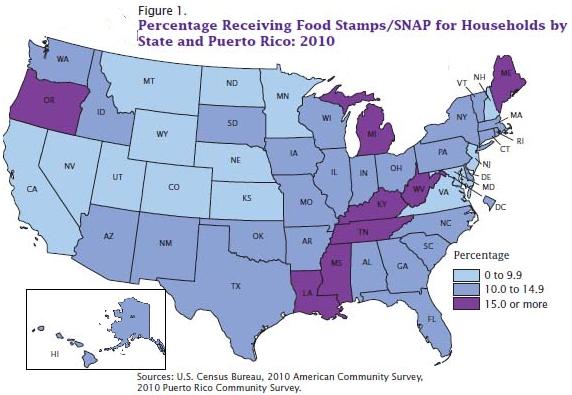

In others, only a small number of households are eligible for the services. In some states, virtually all food stamp households are eligible for the TANF/MOE-funded benefit program. Under the Food Stamp Program, households that receive a TANF/MOE-funded benefit are “categorically eligible” for food stamps and do not have to meet the food stamp asset test in order to receive benefits. Alternatively, states may employ in the Food Stamp Program the vehicle asset rule from a TANF/MOE-funded benefit or service program for households that are authorized to receive that TANF/MOE-funded benefit. For example, Pennsylvania and Arkansas apply their TANF cash assistance policy to exempt one vehicle per household and then apply federal food stamp rules to all additional vehicles. They may, however, merge their TANF/MOE-funded assistance program rules with food stamp rules in order to ensure that the final policy addresses all vehicles in a method no more restrictive than federal policy. These states are not permitted to simply import their TANF cash assistance rules into the Food Stamp Program because it would make many households with multiple vehicles worse off. Federal food stamp rules permit households to own multiple vehicles, albeit vehicles with a very low value. In many states, the cash assistance vehicle asset rule limit applies to only one vehicle and households with multiple vehicles are not generally eligible for TANF cash assistance.

Wisconsin, Missouri, Colorado, and others do the same with their child care assistance programs. These states have now imported this rule into the Food Stamp Program, ensuring that vehicle ownership will never prevent their residents from getting food stamp assistance. For example, Alabama, Ohio, Kansas, Utah, and Maryland are among the states that exclude the value of all vehicles in its TANF cash assistance programs. States may now use in the Food Stamp Program the method for valuing vehicles that the state has established under a TANF/MOE-funded cash or non-cash assistance program so long as it is not more restrictive than federal food stamp rules. States have two methods by which they may exempt vehicles from consideration as assets in the Food Stamp Program policy: aligning food stamp policy to federal TANF or state Maintenance of Effort (MOE)-funded assistance programs or using the asset rules in a TANF/MOE-funded benefit program for households authorized to receive that benefit.Īligning Food Stamp Policy to TANF-MOE-funded Assistance Programs. (See David Super and Stacy Dean, New State Options to Improve the Food Stamp Vehicle Rule, Center on Budget and Policy Priorities, January 19, 2001). It is also out of step with the vehicle policy improvements many states have made in their Temporary Assistance for Needy Families (TANF) cash assistance and Medicaid programs.įortunately, states have a great deal of flexibility in crafting a food stamp vehicle asset rule that suits their needs. The federal policy no longer meets the goal of allowing low-income households, especially working families, to own reliable means of transportation.

For the vehicle limit today to have the same real value that the $4,500 limit had in 1977, it would need to be set at more than $11,000. (This is only the first step of a complex vehicle asset rule, See Appendix: The Federal Food Stamp Vehicle Resource Test.) The exemption was not indexed to inflation and has been raised by only $150 in 26 years. The Food Stamp Act of 1977 required states to count the fair market value of a car as a resource to the extent that the fair market value (FMV) exceeded $4,500. The existing federal food stamp vehicle asset policy has been outdated for some time. This paper provides information about each state’s policy and which option the state utilized to set its vehicle policy. However, nine states still limit the value of the cars participants may own. Forty six states have used this flexibility to exempt at least one vehicle from consideration in determining food stamp eligibility. States have great flexibility to set the food stamp vehicle asset policies to ensure that needy households can get the help they need and still have reliable transportation.


 0 kommentar(er)
0 kommentar(er)
